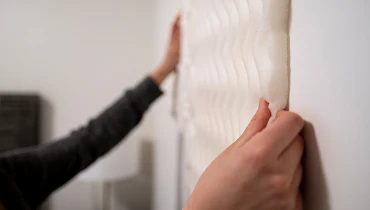Make Your Room Soundproof with These Easy Steps
Last Edited: 9/15/23
Modern life is noisy. Whether it’s the dull roar of nearby highway traffic or your neighbor’s barking dog, too much noise can disturb sleep and make peace-and-quiet seem like a relic of the past.
Not only is it annoying being bombarded with constant noise, it’s unhealthy. Studies have found a significant link between environmental noise exposure and high blood pressure, heart attacks and strokes.
That’s why learning how to make a room soundproof may be a lifesaver! (Interesting side note: the word “noise” originates from Latin word nausea, meaning “discomfort, seasickness.”)
How to Block Noise from Outside
Outside noises seep into our homes through windows, walls and exterior doors. If you’re trying to block noise from a temporary situation – a raucous lawn party across the street, for example –placing a mattress against the door and hanging thick blankets over the windows may be enough do the trick.
Another temporary option is to use window plugs, which can be placed and removed as needed. Window plugs can be made with a thin wooden board, a soundproof or rubber mat, and acoustic foam.
If you’re seeking a more permanent way to block outside noise, consider these tips:
- Install heavy thermal curtains over windows or, for better results, use soundproof drapes that lie flat against the window.
- Hang a heavy blanket or curtain over exterior doors. (You can purchase soundproof blankets to fit doors.)
- Use acoustical caulk or noise-proofing sealant to seal window and door trim. Regular caulk shrinks as it dries and may crack, but special acoustical sealants remain flexible and provide better sound blockage.
- Place thick draft-stoppers under exterior doors or install a rubber door sweep for larger gaps.
- If you don’t already have a storm door, install one to add an extra layer (“dead air space”) of sound protection to your exterior door.
- Install soundproof windows or add window inserts (clear panes of acrylic or glass) over existing windows to create a more airtight seal, reducing both incoming noise and drafts.
Implementing these soundproofing strategies will also serve to upgrade your home’s energy-efficiency, as many double as energy-efficiency improvements.
How to Soundproof a Room
Making a room entirely “soundproof” may not be practical, but there are ways to greatly reduce noise transfer from room to room – and improve acoustics while you’re at it. Filling in gaps or holes where sounds leak, minimizing vibrations and using sound-absorbing materials will help keep noise levels in check.
Before you take steps to make a room soundproof, identify your objective: Are you seeking to create a quiet space to work or sleep? Or, are you the noisy one trying to keep the din from escaping your room? Think about the types of noise you want to block and whether they are high or low frequency sounds. Do you really need soundproofing or do you want to improve acoustics to record podcasts or videos?
Since some materials and strategies work better for specific sound issues, knowing what you want to accomplish is essential.
Soundproofing materials work by repelling or deflecting sound waves, while noise-reducing items absorb sound waves to minimize them. If you want to block noise, choose materials that are labeled “soundproof” rather than ‘”noise-reducing.” If you want to improve acoustics and reduce feedback and echoes within the room, choose soft, dense materials to absorb sounds. For optimal results, use both soundproofing and noise-reducing items together, experimenting with placement until you find the right mix.
Keep Noise Out
If you want to keep excess sound out, pay attention to where noise is coming from and focus on those sides of the room. Before you start replacing drywall, try these budget-friendly options:
- Place a floor-to-ceiling book case against the interior wall and fill it with your thickest books.
- Buy a bundle of moving blankets, soundproof blankets or curtains to mount to walls. As an alternative, use layers of thick conventional blankets or carpeting.
- Remember that small gaps let sound creep in: electrical outlets, switches and door gaps are a few examples. Use soundproof caulk to seal cracks and add door sweeps below doors.
- Reduce noise travel in air vents by inserting vent filters, or cover unneeded vents with acoustic foam for a quick fix.
- Attach fabric-backing to wall-mounted items like pictures or mirrors and use rubber floor mats under speakers, appliances and other noisy appliances to minimize vibrations.
- Consider replacing hollow interior doors with solid-core doors.
- Noisy upstairs neighbor? Line your ceiling with acoustic foam, carpeting squares or a thick shag rug to blunt the sound of heavy footsteps from above.
- Attach acoustic foam or ready-made acoustic panels to walls and/or ceiling using adhesive spray or mounting strips. (You can either attach the foam directly to walls or make your own panels, which can be moved as needed.)
Keep Noise In
If you’re the one who’s making the racket – maybe you love those high-octane video games – you probably want to keep excess noise from escaping the room. Following the steps above should help, but you’ll need to cover the entire room instead of just one or two walls.
In this case, using soundproofing items — blankets or curtains — to cover walls, along with strategically-placed sound-absorbing panels, may work best. If the room is upstairs, add dense rubber floor mats or thick rugs over existing flooring.
Make Acoustic Panels
As an affordable alternative to store-bought acoustic panels, you can make them yourself using acoustic foam or other materials. Acoustic foam is typically available in squares, wedges and rolls. Measure the space to cover and find the best option for your project. For the panel backing, use thin wood boards or repurpose cardboard for a light-weight alternative.
How to make your own acoustic panels:
- Cut the acoustic panel to uniform sizes based on the area you plan to cover.
- Use double-stick construction tape or adhesive spray to attach acoustic foam (textured side up) to the backing, or try soundproofing tape or glue for an extra layer of sound protection.
- If you don’t have acoustic foam, other materials may work in a pinch. Some have reported success using old bath towels, dense blankets and thick carpet squares. Cut to size and attach to backing. You may want to layer materials for better sound absorption.
- Hang panels side by side, covering the entire wall. To avoid damaging underlying drywall, use removable mounting strips.
How to Make a Soundproof Room
If you’re looking for more than just noise reduction, break out some tools and get ready to remodel! Adding a layer of drywall over the existing wall is one of the most effective ways to make a soundproof room. For best results, use soundproof drywall or thicker (5/8-inch) drywall, and use a soundproofing compound like Green Glue to attach the new drywall sheets directly to the existing drywall.
Another option: attach mass-loaded vinyl to existing walls before adding the second drywall layer. Finish the job with soundproof paint or soundproof wallpaper, available in a variety of colors and styles.
Hire a Professional: Professional Soundproofing Services
Although there are steps you can take to make a room soundproof, your best bet is to let an expert handle the job. Mr. Handyman can create a quiet, tranquil space for you — or one where you can explore your inner rock star without disturbing the neighbors. Call us today or visit us online to learn more.
 Click to call
Click to call


